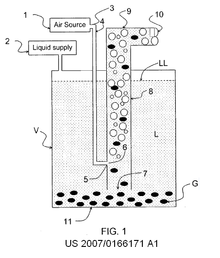Hydroculture/Horticultural aquaponics/Easy top-drip aquaponics system
This is representative of a hybrid bubbleponics and aquaponics system.
Components[edit | edit source]
All component materials should be nonhazardous/noncancerous. See Horticultural aquaponics/Instructional hints and tweaks
- tote (or a 5 gallon bucket) with lid
- additional container with open lid for easy fish feeding and maintenance. see Hydroculture/Horticultural aquaponics/Aquatic subsystem
- air pump, and tubing
- micro-tubing connectors
Lid[edit | edit source]

Place net-pots upside-down on the tote-lid, and leave a space vacant in the center for the micro-tubing adapter to come through. Mark the outline of the net-pots, and the center of the tote with a pencil. Use a marker to mark about 1/4in inside of the outline of the net-pots. (The lip of the net-pot must rest on the lid) Use a (hand or power) drill, that is the same outer diameter as the micro-tubing coupler, to make a hole in the center of the tote-lid. The center hole needs to be narrow enough so the micro-tube cannot go through, but wide enough for the micro-tubing connector to fit. If a mistake is made here, a wider size microtubing is one way of fixing this, or making a hole to insert a test-cap, to try this again, is another way. Cut holes out for the net-pots. (As mentioned before, make sure the hole is smaller than the outer diameter of the net-pot, so the net-pot won't fall through.)
Airlift pump[edit | edit source]

The benefits using an air-pump is: that it is convenient to buy, that it is not allowed to be underwater causing an electrical hazard and that not a lot of water pressure is required in this system. The aquarium pump will sit higher than and outside the aquaponics unit, and it will serve the function of an airlift pump.
An airlift can be made with microtubing and a T connector. First, connect the middle part of the T to the air supply in. Then, connect a short length of microtubing to one end of the T, and the fountain out to the opposite end. A micro barb coupling can be inserted on the fountain end of the microtubing to allow a narrow opening to make the water sputter further. This can also be used to connect the fountain end of the microtubing to the top of the tote lid. The water input should be lower than the air input, and a weight may be necessary.
If done properly, once the tote is filled with water, the air inside of the microtubing will push the water up to spill on the top of the container-lid.
Timer[edit | edit source]
The timer only needs to be on to run the air pump enough to wet the substrate material, and needs to turn on a few times a day, at minimum for plant health. This eliminates the need for buying an expensive timer (required for a true aeroponic system), or having to build your own through dc circuitry. The substrate material does enough to keep the plant's roots moist between waterings. However, the timer should turn on often, or be left on without the timer, to aerate the fish and the tank and for improved plant growth. (a mechanical timer with settings for 30 or 15 minutes on/off will work) Plants need about 6 hours a day of darkness. Water falling back towards the tote aerates the water. Hook the timer to both the led (or fluorescent) light and air pump. Choose a bright light, and put the system near a window. (Its ok to have both turn on at the same time, allow the timer to turn on less often at night)
Final steps[edit | edit source]

Wipe down inside of tote, cleaning up fragments. Add water and fertilizer solution (see above) to the tote. Use de-chlorinated water or let system run for a few minutes beforehand to de-chlorinate: chlorine dissipates on contact with air, and chloramine takes longer to dissipate. Set in lid and net-pots. 1 net pot can be left out to let light in for the fish, but not too much light should be let in, for plant root health. Fill the net-pots half way with substrate material. Add bulbs, stem cuttings or seeds. (Don't use plants dangerous to fish). Let plant stems grow before adding the rest of the material. Rockwool is not aerated enough, so it may be ideal for balling around small seeds or for layering around a stem cutting. Most material needs to be a porous. Coco-peat helps prevent fungus formation.
Ornamental fish[edit | edit source]
Use a connected container with the top uncovered for fish. This makes it easier to feed and maintenance the fish. Add goldfish: goldfish seem to graze on algae. Algae eaters, shrimp and snails are optional for cleaning up algae. Feed fish daily. The fish in this type of aquaponic system are hardier than plants. Once the fish are established they do the work of keeping the fertilizer level stable.